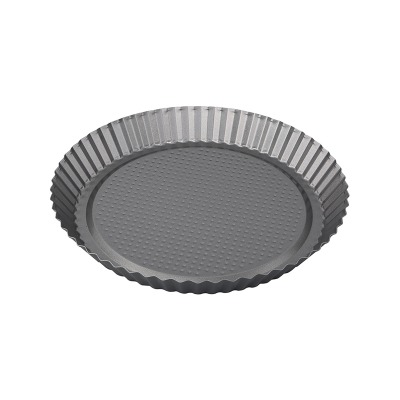
China aluminum tart pans Exporter
Aluminum tart pans have become a staple in kitchens around the world, prized for their lightweight nature and heat conductivity. The origins of aluminum bakeware can be traced back to the early 20th century when aluminum began to be widely used in cookware due to its affordability and efficiency. As bakers sought materials that could provide even heat distribution, aluminum emerged as a popular choice. Over the decades, the design of aluminum tart pans has evolved, with various shapes and sizes catering to different baking needs.
One of the key advantages of aluminum tart pans is their ability to conduct heat evenly, which is crucial for achieving a perfectly baked crust. Unlike heavier materials, aluminum heats up quickly and cools down just as fast, allowing bakers to have better control over their baking process. This feature is particularly beneficial when making delicate pastries or tarts that require precise baking times. Additionally, many modern tart pans come with a non-stick coating, making it easier to release the tart without damaging its structure.
However, despite their many benefits, users often encounter common issues when using aluminum tart pans. One frequent problem is the tendency for aluminum to react with acidic ingredients, such as fruits or citrus. This reaction can cause discoloration of the food and may impart a metallic taste. To mitigate this, it is advisable to line the aluminum tart pans with parchment paper or to use anodized aluminum pans, which have a protective layer that prevents such reactions.
Another common concern is the durability of aluminum tart pans. While they are generally robust, they can be prone to scratching and denting if not handled carefully. To extend the life of your aluminum tart pans, it is essential to use non-abrasive cleaning tools and to avoid stacking them without protective layers in between. Hand washing is recommended over using a dishwasher, as the harsh detergents and high temperatures can degrade the non-stick coating over time.
When it comes to baking with aluminum tart pans, proper preparation is key. Before pouring in your tart mixture, ensure that the pan is well-greased or lined to prevent sticking. This step is particularly important for recipes that involve a wet filling, as it can help maintain the integrity of the crust. Additionally, preheating the oven is crucial; placing a cold aluminum tart pan in a hot oven can cause uneven baking and potential warping of the pan.
For those who are new to baking, using them can be a bit of trouble. However, with practice, it becomes easier to achieve beautiful results. Start with simple recipes that require minimal ingredients and techniques. As you gain confidence, you can experiment with more complex tarts that showcase your skills. Remember, the key to a successful tart lies in the crust, so take your time to ensure it is well-prepared.
Aluminum tart pan‘s lightweight design and heat conductivity make them ideal for creating a variety of tarts. By understanding the common issues associated with aluminum tart pans and following practices for their use and care, you can enjoy the many benefits they offer. Whether you are baking a classic fruit tart or a savory quiche, they will help you achieve delicious results every time. Embrace the versatility of aluminum tart pans in your baking endeavors, and you will find that they are a good company in the kitchen.

 English
English 中文简体
中文简体 Deutsch
Deutsch